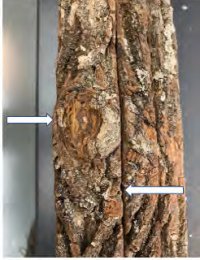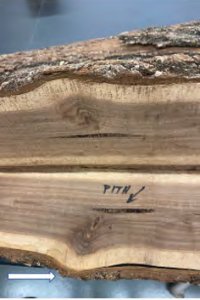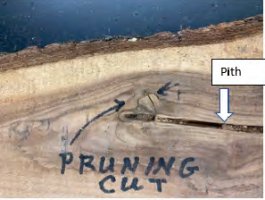AgEBB-MU CAFNR Extension
Green Horizons
Volume 25, Number 1
Winter 2021
The Amazing Cover-up
Lynn Barnickol, Missouri Consulting Foresters Association
Political cover-ups are pretty amazing but more amazing is how trees respond to wounding. When a tree is wounded the tree goes to work as the conductive tissues of inner bark, cambium and sapwood are exposed to harmful bacteria that causes decay. Exposed wood can also attract wood boring insects. Fungal decay spores are in the air and infect the wound immediately. Although a grim situation, many trees survive wounds, but quality of the wood and health of the tree can be at stake.
 |
Figure 1. Arrow points to a "cat face", a distortion in the bark indicating the location of a limb that has been removed. Typically, bumps on logs signal the location of a missing branch. Inside the bark is a knot where a limb was growing and where the tree responded to cover a wound. Note the saw line in the center of the 6-inch diameter log. |
Your black walnut plantation, your timber stands, or the tree shading your home are all examples of a huge investment worth protecting. Wounds can cause decay and stains that reduce the value of the timber and wood products, and be limiting factors that shortens their life as shade trees. Wounds allow disease to become established in a tree. Intentional scars from pruning or accidental wounds from fire or mechanical damage during lawn mowing or logging cause your trees react to protect themselves through compartmentalization of the wound. University of Missouri research shows that wounds from prescribed and wildfire can range from non-existent to expensive, depending on the size of the fire scaring and length of time until harvest, resulting in both loss of volume and product value.
Surgery or accidental cuts that break our skin require a response of our bodies to heal. If the cut is small there is no perceptible record the injury occurred as our bodies regenerate healing tissues. Trees do not have the ability to regenerate tissue but they do react to the wound by building protective walls of cells that are reinforced by deposits of lignin and extractives in response to the wound. The four-step process is called compartmentalization of decay in trees or CODIT for short. It's a concept documented by Dr Alex Shigo.
 |
Figure 2. The log was sawed to reveal the inside or heart center of the log. Arrow pointing to the bump where wood has formed around the knot from a pruned limb. Note, the limb originates at the pith; it's the biological center of the tree. The limb as living when pruned but wood rapidly compartmentalized the wound so little decay is present. |
Steps 1 and 2) The tree uses lignin to plug pores and vessels above and below the wound attempting to isolate spread of decay through sapwood. 3) A wall forms to the inside of the wound comprised of extractives and lignin to seal the ray cells form transmitting decay toward the heart. 4) Finally, new growth from the healthy cambium attempts to create a living wall of wood to seal the wound to the outside. Over time the wound caused by pruning will result in a cat face (Figure 1) or distorted bark serving as a record of the wound. Even when the cat face is totally concealed by new wood there will be a record of the pruning scar that is revealed when veneer or lumber is sawed from the log. Ideally, the pruning scar is concealed deep within the log so yield of veneer or high grade lumber realized.
 |
Figure 3. Note how close to the pith this pruning cut was made. The limb was |
Readers who have attended Walnut Council meetings may have seen Harlan Palm's description of compartmentation of pruning scars. Let's take a trip from the bark into the heart center of a log. The log was cut during a thinning project in Harlan's walnut plantation and was milled to expose the pruning scars. Pictured below reveals how the tree compartmentalizes the pruning wound. Healthy, rapidly growing trees have a better chance to successfully compartmentalize wounds and any associated decay that stressed the trees. Consulting forester Fred Crouse reports anecdotally, that failure to prune off lower branches when the tree is young can lead to a significant reduction of product value. Pruning early in the tree's life is advisable as it helps keep wounds small and allows time for clear wood to cover the wound (Figure 2 and Figure 3).
References and additional information:
http://walnutcouncil.org/wp-content/uploads/2018/07/Walnut-Pruning-Guide.pdf
http://walnutcouncil.org/wp-content/uploads/2019/10/Pruning-Black-Walnut-for-Veneer.pdf
http://walnutcouncil.org/wp-content/uploads/2018/11/When-to-Prune-Black-Walnut-trees.pdf
https://www.extension.purdue.edu/extmedia/FNR/FNR-76.html
https://www.nrs.fs.fed.us/pubs/misc/ne_aib405.pdf
http://faculty.missouri.edu/~stambaughm/2014_Marschall_etal_FORECOL.pdf
https://www.purdue.edu/fnr/extension/equipment-damage-to-trees/
